John Veverka & Associates
Main menu:
- Home Page
- Our Range of Services
- Interpretive Coaching
- Interpretive Planning
- Interpretive Plan Outline
- 2015 - 2016 projects
- 2013/2014 projects
- 2012 Projects
- 2011 projects
- Interpretive Training
- John Veverka Resume
- Qualifications
- NEW Advanced Interp. Text Book
- InterpNEWS
- Library
- Expert in Interpretation
- JVA NEWS, Courses and Updates
- Certificates
- Planning/Design of Interpretive Panels
- Interpretive Writing
- Interpretive Writing Course
- Interpretive Trails Course
- Interpretive Panels Course
- Introduction to Heritage Interpretation Course
- Interpretive Planning & Design of Marketing Brochures Course
- Training for Interp. Trainers
- Interpretive Exhibits Course
- Interpretive Master Planning Course
- Interpretive Planning for Scenic Byways.
- Critiquing and Coaching Interpretive Staff
- Advanced Interpretive Planning
- Interpretive Training Center Course Catalogue
- Interp. for International Visitors course.
- Interpretive Exhibits Evaluation
- Interp. Center Feasibility Analysis Course.
- Interp. for Commercial Tour Providers
- Interpretive Researchers Guide for Visitor Studies
- Interp. Planning for Historic Homes
- Heritage Interpretation Training Center
- Interpretive Planning for Botanical Gardens
- An introduction to planning and presenting live interpretive programs and tours for Museum/Heritage Site Docents and Volunteers.
- Developing Marketing Plans for Heritage & Tourism Sites and Attractions
- Interpretation Book Store
- Heritage Interpretation Resource Center
- Interpretive Planning for Historic Farms
- Developing Successful Partnerships
- Developing Interpretive Outreach Programs
- Community Interpretation Planning
- Interpreting Gravestones and Historic Cemeteries
- Using Interpretation to Accomplish Management Objectives.
- An Interpreters Guide for Survival Economics.
- Innovative Strategies for Interpretive Media and Services Planning.
- A Curators Guide for Developing Gallery Tours.
- Advanced Interpretive Writing - Technical Publications
- Advanced Interpretive Services for Managers, Supervisors, Team Leaders and Sr. Staff.
- Advanced Interpretation for Chiefs of Interp. - Interpretive Managers - Regional Interp. Specialists
- Interpreting Critical Issues.
- Developing Commercial Interpretation for Resorts, Cruise Ships, Campgrounds and Tourism Attractions.
- Planning and developing a new commercial tour guiding business.
- Interpretive Evaluation, Visitor Studies and Site Assessment Center
- The Center for Interpretive Planning Advancement & Excellence.
- Developing Requests for Proposals (RFPs)
- Planning and Facilitating Focus Workshops
- InterpNEWS Advertising Details
- Planning for Interpretive Experiences
- 40 Years a Heritage Interpreter
- Interpretive Techniques - The Rest of the Story Course
- Certified Professional Interpretive Planner Certificate
- Certified Professional Interpretive Program
- Certified Professional Interpretive Trainer certificate program.
- Certified Professional Heritage Interpreter certificate program.
- Certified Professional Interpretive Writer certificate program.
- Visitor motives for attending interpretive programs.
- Exhibit Rehab Course
- Developing Training Workbooks & Manuals
- Planning for Railroad Museums and Sites.
- Climate Change Interpretation Course.
- When there's nothing left but the story - interp. storytelling.
- Interpreting Legends Myths and Fables
- InterpTalk - Interpretive Planning Seminars
- InterpSHARE Seminars for May 2022
- Interpreting Invasive Species
- Interpretiing Edible Insects
- Interpretaive Planning for Climate Change
- HITC Climate Crisis Resource Center
- PUP Members Only
- Veverka's Interp. Blog
- Starting a new Interp Consulting Business
- Panels 4 Week Course
- Interpretive Writing - 4 Week Course
- Marketing - 4 Week Course
- Intro to Interpretation - 4 Week Course
- Interp Climate Change - 4 Week Course
- Exhibit Rehab 4-Week Course
- Level 1
Veverka's Interp. Blog


Veverka's Blog for Heritage Interpreters
http://www.heritageinterp.com/veverkas_interp_blog.html
jvainterp@aol.com
Freedom never came easy - are we loosing it? Happy 4th.
26 June 2022 - Hi and welcome to my June 2022 blogs. More updates coming for June so don't worry. Got a lot going on for June and for July- new courses and working on textbooks. Here's some of what's planned.
New courses for July 2022.
Introduction to Heritage Interpretation -
14 Units - 2 CEU credits. $200.00
The basic college level entry course into what makes the message or media "interpretive"? Provoke, Relate and Reveal, theme development, interpretive objectives and developing the message to be as inspirational and memorable as informational.
Introduction to Heritage Interpretation Course
-----------------------------------------------------------
Interpreting the Climate Crisis - 2022
Interpretive Planning for Programs, Exhibits, Panels and Related Services To Help You to Interpret Climate Change and Global Warming Issues to Your Audiences, Communities and Regions.
13 Units, 4 CEU's $250.00. Our Climate Change special resource issues will be included.
Interpretive Planning for Climate Change (heritageinterp.com)

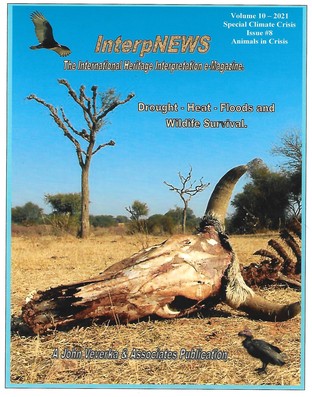
------------------------
Interpreting Legends, Myths and Fables. Storytelling when folklore is already part of our cultures.

Our cultures are surrounded by legends, myths and fables, all of which had (or still have) important cultural connections. This course is to help you re-discover your sites or regions stories and present them to your visitors, weather around an evening campfire, a guided walk in a historic district or cemetery, through a cultural heritage museum exhibit.
Interpreting Legends Myths and Fables (heritageinterp.com) ($200.00 course tuition)
--------------------------------------------
--------------------------------------------------------------------------------------------------------------------------
- Two new interpretive text books in the mill:
- Economics for Heritage Interpreters
- The Interpretive Exhibit Planners Toolbox.
- Visit my new new Climate Crisis/interpretation Resource Center:
http://www.heritageinterp.com/hitc_climate_crisis_resource_center.html
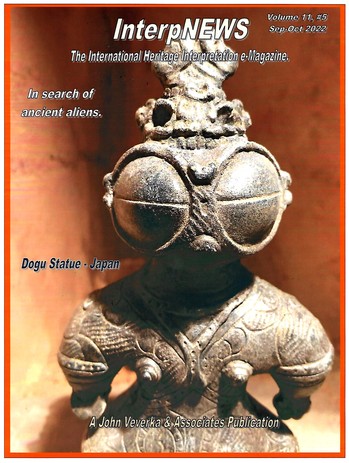
What climate crsis? Sea levels rising now.
--------------------------------------------------------------------------------------------------------------------
Next FREE Late June InterpSHARE Seminars
If you would like to attaend any seminar just send me an e-mail for which one(s) you would like to attand and I will send you the zoom link and handout references - John V. jvainterp@aol.com.
----------------------------------------------------------
Planning two new seminars for late June - one on marketing to get visitors to come back to your site, and create new market groups. One seminar on visitor surveys - what experiences to your visitors really want? Watch for detains in the next blog.

Lots of reference materials will be provided for these seminars.
-------------------------------------------
InterpNEWS coming for June/July and Aug/September
Watch for them - awsome articles.


Lost Civilizations Issue (left) and In Search of Ancient Aliens Issue.
Subscriptions to InterpNEWS are Free!! jvainterp@aol.com to be added to the mailing list.
-------------------------------------------------------------------------------------------------
New Stories For InterpSHARE
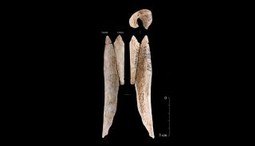
Iron Age arrow found on Norway mountain still has feather fletching on it
By Laura Geggel published 28 days ago
It's even more spectacular than Ötzi the Iceman's arrows.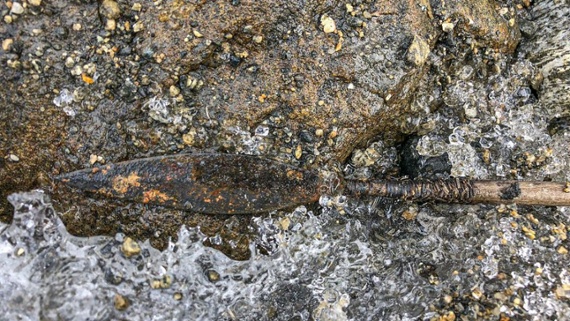
Archaeologists used warm water to melt the ice and snow around this Iron Age arrow
found in Norway. (Image credit: Espen Finstad/secretsoftheice.com)
A spectacularly preserved arrow from the Iron Age — complete with its iron arrowhead, sinew wrappings and aerodynamic feather fletching — is now in the hands of glacial archaeologists in Norway.
It's rare for arrow fletching to preserve, as the delicate feathers that help guide the arrow in flight usually decay over time. The arrows of Ötzi the Iceman, who died about 5,300 years ago in what is now the Italian Alps, also have preserved fletching, although their condition isn't as good as that of this newly discovered 1,700-year-old arrow, the archaeologists said.
"I think it is perhaps just the Ötzi-find which has preserved fletching on arrows, but his arrow fletchings are nowhere as well preserved as some of ours," Lars Pilø, an archaeologist at the Department of Cultural Heritage, Innlandet County Council, Norway, co-director of the Glacier Archaeology Program, told Live Science in an email. However, "his are older too, by several thousand years, so this is not to diss Ötzi's arrows," Pilø said.
The archaeologists found the 31.5-inch-long (80 centimeters) arrow during a survey at an undisclosed site in the Jotunheimen mountains in southern Norway in 2019, the glacial archaeology group Secrets of the Ice announced on Twitter(opens in new tab) on April 28.
"It is probably the best preserved arrow we have found so far," said Pilø, who is also editor of the Secrets of the Ice website. For instance, the sinew, wrapped around the front end of the arrow shaft to reduce the risk of fracture on impact, is still "wrapped tightly" and in place, he said. The remains of the thread and tar used to craft the arrow are also present.
"No wood species determination has been made, but the shafts of this type tend to be made in pine," Pilø added. "Hopefully, it will be possible to find out which birds the feathers come from, what animal the sinew came from, etc."
The team decided to forgo radiocarbon dating, as they would have to destroy part of the arrow when taking a sample to test its carbon isotopes (variants of the element carbon). They would rather the entire arrow stay intact for when it goes on display in a museum, he said.
https://www.livescience.com/iron-age-arrow-norway-mountain?utm_source=SmartBrief&utm_medium=email&utm_campaign=368B3745-DDE0-4A69-A2E8-62503D85375D&utm_content=671729CA-48DB-4F41-AB7C-FE0489CFB393&utm_term=33fcb0f1-f2b6-4f1c-8537-5e81e2ec5f62
------------------------------------------------------------------------------------------------------------
Astonished fishers reel in gigantic 400-pound stingray in Cambodian river
By Harry Baker published 28 days ago
Experts say that these monstrous rays can grow even bigger.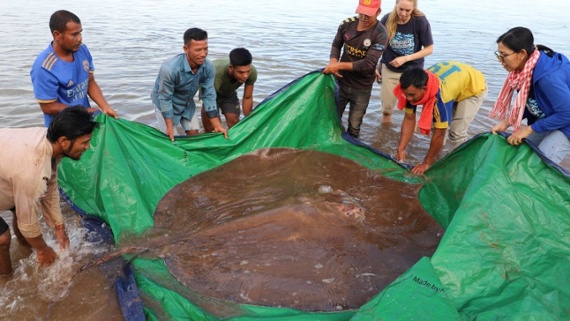
Local fishers show off the massive stingray, with its long venomous tail, that they caught
in the Mekong River in Cambodia. (Image credit: Wonders of the Mekong project)
Fishers in Cambodia recently received a massive surprise when they reeled in a gigantic 400-pound stingray. The hefty ray was dragged up from the murky depths of the Mekong River after it swallowed a fish that had already been snagged on the fishers' line.
The monstrous ray, which has been identified as a giant freshwater stingray (Urogymnus polylepis), was accidentally caught by locals on May 5 in the Stung Treng province in northeastern Cambodia. The fishers immediately alerted team members from the Wonders of the Mekong project — a conservation group run by the University of Nevada, Reno (UNR), in collaboration with local fishing authorities — who helped remove the fishing line and measure the ray before safely releasing it back into the river.
The massive specimen weighed a hefty 397 pounds (180 kilograms) and measured 6 feet (1.9 meters) wide and 13 feet (4 m) in length including its whip-like tail, which terminated in a 6 inch (15 centimeter) venomous, serrated barb, UNR representatives said in a statement.
Giant freshwater stingrays are the world's largest stingray species and "are contenders for the title of world's largest freshwater fish," Zeb Hogan, a UNR fish biologist and director of the Wonders of the Mekong project, told Live Science.
https://www.livescience.com/gigantic-stingray-caught-in-cambodia?utm_source=SmartBrief&utm_medium=email&utm_campaign=368B3745-DDE0-4A69-A2E8-62503D85375D&utm_content=671729CA-48DB-4F41-AB7C-FE0489CFB393&utm_term=33fcb0f1-f2b6-4f1c-8537-5e81e2ec5f62
------------------------------------------------------------------------------------------
Broken pieces of rare Viking sword reunited after 1,200 years apart
By Joanna Thompson published about 7 hours ago
The sword's hilt is richly decorated with gold and silver.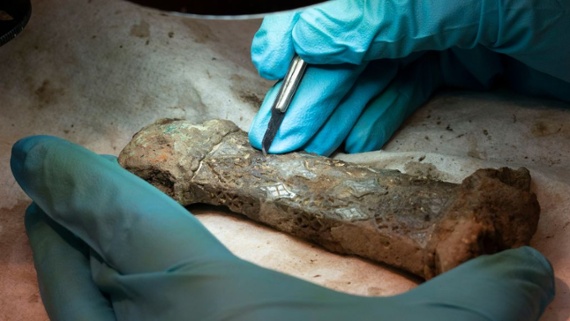
A researcher examines the remains of a Viking Age sword discovered
in Norway. (Image credit: Lise Chantrier Aasen/Stavanger Museum)
Two pieces of an ornate Viking sword that had been separated for about 1,200 years have been reunited and still fit together like a puzzle. The pieces were discovered a year apart by amateur treasure hunters in Norway.
The first finding occurred last year, when a metal detectorist in Stavanger, along Norway's west coast, uncovered a small, odd piece of metal while poking around a farm. The man handed the fragment over to the local archaeological museum and was unsure what it was — until this spring, when his friend and fellow metal detectorist unearthed the rest of the artifact nearby. Those two small chunks of metal turned out to be part of a massive Viking Age sword.
The sword is "of a rare type, known from Scandinavia but also found in Western Europe (in the areas known today as France, Britain and Ireland) and Eastern Europe, e.g. Hungary," Ann Zanette Glørstad, an archaeologist at the University of Oslo in Norway, told Live Science in an email. Though the blade is missing, the sword's hilt is richly decorated with intricate carvings and gold and silver details. Each end of the cross-guard is shaped like an unidentified animal.
Based on its ornamentation, Glørstad thinks that the sword may have been forged in the Frankish Empire or England around 800 A.D. However, it could possibly have been forged by a talented Norwegian smith who was inspired by Frankish weapons, she noted. Of the roughly 3,000 Viking swords recovered in Norway, only about 20 match the newly discovered weapon's profile — and its owner remains a mystery.
Swords from this era sometimes had their owner's names inscribed on the blade, according to the Art Institute Chicago(opens in new tab), but because this weapon's blade is lost, archaeologists will have to rely on other clues to infer its owner's identity.
The area has seen its share of Viking royalty; in 1883, the grave of a rich Viking queen was unearthed not far from where the sword was discovered. "We knew that this area was of special importance, but that we should find something like this was very unexpected!" Håkon Reiersen, the acting head of the museum's collection department, said in a translated statement(opens in new tab). The sword has joined the collection at the Stavanger Museum of Archaeology, where it will be on display once it has been properly restored and preserved. In the meantime, archaeology enthusiasts can follow the museum's website(opens in new tab), Instagram(opens in new tab), and Facebook page(opens in new tab) for updates on the sword's restoration.
https://www.livescience.com/rare-viking-sword-discovered-norway?utm_source=SmartBrief&utm_medium=email&utm_campaign=368B3745-DDE0-4A69-A2E8-62503D85375D&utm_content=77DC6A71-64EE-46E9-AD28-A00812FCEA04&utm_term=33fcb0f1-f2b6-4f1c-8537-5e81e2ec5f62
---------------------------------------------------------------------------------
Metal detectorist in UK finds ancient Roman penis pendant
By Owen Jarus published about 3 hours ago
Silver penis pendants like this are rare.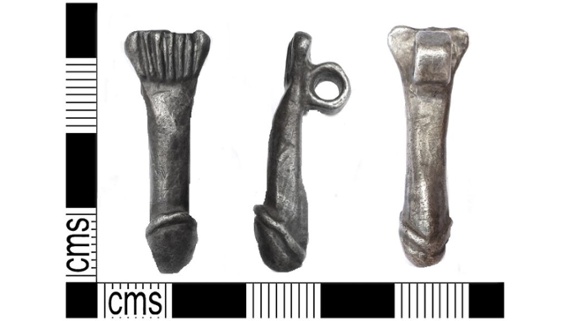
This Roman pendant made of silver depicts a penis. The streaks at the top
appear to depict pubic hair. (Image credit: Courtesy Portable Antiquities Scheme)
A metal detectorist recently discovered a silver, penis-shaped pendant in Kent, England that was likely worn around the neck to protect a person from misfortune around 1,800 years ago.
Ancient Roman writers such as Marcus Terentius Varro (lived 116 B.C. to 27 B.C.) and Pliny the Elder (A.D. 23 to 79) mention how the phallus and representations of it are thought to have had the power to protect a person from evil. Many depictions of the phallus have been found throughout the Roman Empire and scholars often believe that they were created to avoid bad luck.
The pendant (also called an amulet) is about 1.2 inches (3.1 centimeters) long, with a tiny ring at the top for a string (necklace) to go through. It dates back to a time when the Romans controlled England, between A.D. 42 and 410.
While such amulets in the shape of a penis were frequently seen throughout Roman Britain, they are typically made of copper-alloy rather than silver like the one from Kent, Lori Rogerson, a finds liaison officer with the Portable Antiquities Scheme (PAS), wrote in a report(opens in new tab) on the artifact.
"Being a higher-quality metal than copper-alloy, silver may have been thought to strengthen the phallus' protective abilities," Rogerson told Live Science in an email. "We know that children were protected by these apotropaic [having the power to stop evil] devices, and the archaeological evidence suggests their use in Britain was very popular within the Roman army."
Roman men, women, children and even animals wore pendants like this, in an effort to ward off the so-called evil eye, said Cyril Dumas, a scholar at Musée Yves Brayer who has researched and written about these artifacts. "This amulet is against the effects of 'the evil eye,' a personification of bad luck," Dumas told Live Science in an email.
As for the choice of metal, perhaps the person who commissioned or bought the piece of jewelry had enough money for a higher-quality metal. "The choice of silver as a material can be for many reasons, one of which is simply because the wearer could afford it and the pendant then also becomes an object of display," Rob Collins a project manager and research coordinator at Newcastle University's School of History, Classics and Archaeology, told Live Science in an email. "However, I suspect that silver also has magical properties or affiliations associated with it as a material," added Collins, who has studied and written about artifacts like this one.
Metal detectorist Wendy Thompson found the amulet on Dec. 31, 2020, and she reported her find to the Portable Antiquities Scheme, a program run by the British Museum and National Museum Wales that tracks finds made by metal detectorists. The artifact is now going through the treasure process required by U.K. law, which may result in it entering a museum collection in Britain.
https://www.livescience.com/roman-penis-pendant-found-uk?utm_source=SmartBrief&utm_medium=email&utm_campaign=368B3745-DDE0-4A69-A2E8-62503D85375D&utm_content=77DC6A71-64EE-46E9-AD28-A00812FCEA04&utm_term=33fcb0f1-f2b6-4f1c-8537-5e81e2ec5f62
--------------------------------------------------------------------------------------
'Demon ducks of doom' laid melon-size eggs in prehistoric Australia
By Joanna Thompson published 1 day ago
Scientists crack a 41-year-old mystery about prehistoric eggs.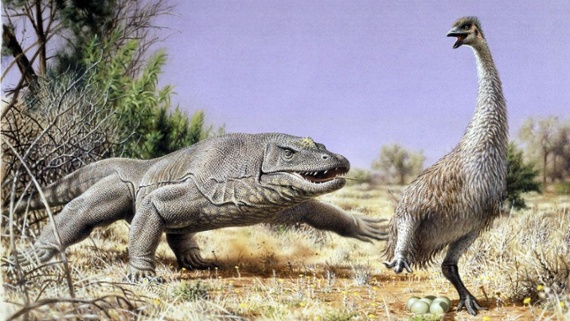
Even demon ducks had predators. Here, the giant "demon duck of doom" (Genyornis newtoni)
flees its nest, pursued by the extinct lizard Megalania (Varanus priscus). Both species lived in
Australia about 50,000 years ago. (Image credit: Peter Trusler)
Scientists have finally cracked a 41-year-old mystery about an ancient eggshell from a large, extinct terrestrial bird with a demonic nickname.
In 1981, researchers in Australia discovered the charred remnants of numerous eggs from several cooking fires used by prehistoric humans, dating to about 50,000 years ago. Some of the eggs were identified as those of emus. But a few oversized specimens belonged to a second, unknown bird. For years, scientists argued about the identity of that large bird. But given the eggs' size and age, over time, two contenders emerged: Progura, a group of large turkey-like birds, or Genyornis, sometimes referred to as "demon ducks of doom" because of their huge size and evolutionary relation to the smaller waterfowl.
Now, a new analysis using sophisticated protein sequencing technology and artificial intelligence has put the debate to rest. The results, which were published May 24 in the Proceedings of the National Academy of Sciences, firmly establish the eggs' identity as Genyornis newtoni, Australia's last "thunder bird."
Genyornis newtoni was an intimidating creature. It stood over 6.5 feet (2 meters) tall and tipped the scales at up to 530 pounds (240 kilograms) of beak, bones and feather-clad muscle, according to the Australian Museum. "I can imagine that having this mega duck looking down at one should be fairly unnerving!" lead study author Beatrice Demarchi, an archaeologist studying bones and other organic materials at the University of Turin in Italy, told Live Science in an email.
Fittingly, these mega ducks also laid large eggs; each weighed around 3.5 pounds (1.6 kg), about the size of a melon. Genyornis' huge eggs would have been an ideal source of protein for Indigenous Australian people, provided they could safely collect them from the big birds' nests. In fact, the scientists now suspect that humans' appetite for the melon-size eggs may have helped drive Genyornis to extinction, according to The Natural History Museum, London.
https://www.livescience.com/demon-duck-of-doom-eggs?utm_source=SmartBrief&utm_medium=email&utm_campaign=368B3745-DDE0-4A69-A2E8-62503D85375D&utm_content=77DC6A71-64EE-46E9-AD28-A00812FCEA04&utm_term=33fcb0f1-f2b6-4f1c-8537-5e81e2ec5f62
--------------------------------------------------------------------------------------------------------------------
Is this the oldest tree in the world?
By Tia Ghose published about 24 hours ago
It's possible that this Gran Abuelo tree found in Alerce Costero
National Park in Chile may be the oldest tree in the world.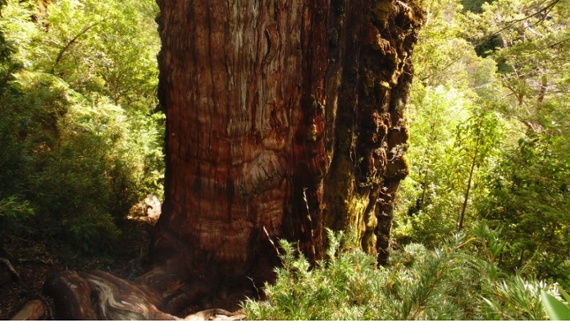
This is a photograph of El Gran Abuelo aka the Great Grandfather Tree.
(Image credit: Yiyo Zamorano, CC BY-SA 4.0 , via Wikimedia Commons)
The world's oldest tree may have been standing for centuries when the first boulders were erected at Stonehenge, new research suggests.
The ancient giant, an alerce (Fitzroya cupressoides) known as the "Gran Abuelo" (or great grandfather in Spanish) that towers over a ravine in the Chilean Andes, may be roughly 5,400 years old, a new computer model suggests. If that date can be confirmed, it would make the Gran Abuelo nearly 600 years older than the current official record holder(opens in new tab) for world's oldest tree, a Great Basin bristlecone pine (Pinus longaeva) in California known as "Methuselah."
However, the alerce's exact age is still somewhat contested, because confirming that requires analysis of the tree's rings — a method known as dendrochronology, and the gold standard for determining a tree's age — and that data is currently incomplete. The underlying data for the model has not yet been publicly released or submitted to a peer-reviewed journal.
Whatever its age, the tree is in peril and needs to be protected, said Jonathan Barichivich, a climate and global ecology scientist at the Climate and Environmental Sciences Laboratory in Paris, and the researcher who created the model.
"It's really in poor condition because of tourism," and the tree has also been affected by climate change, Barichivich told Live Science.
https://www.livescience.com/possible-oldest-tree-found-chile?utm_source=SmartBrief&utm_medium=email&utm_campaign=368B3745-DDE0-4A69-A2E8-62503D85375D&utm_content=77DC6A71-64EE-46E9-AD28-A00812FCEA04&utm_term=33fcb0f1-f2b6-4f1c-8537-5e81e2ec5f62
--------------------------------------------------------------------------------------------------------------
Tomb of ancient Egyptian dignitary who read top secret documents discovered
By Owen Jarus published 24 days ago
Hieroglyphs on his tomb claimed he had royal access.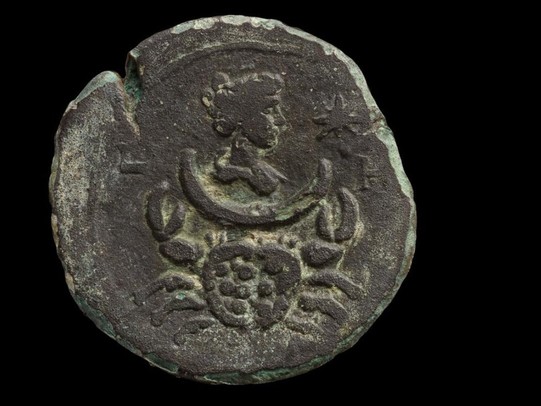
This relief depicts the tomb owner, Mehtjetju, who lived around 4,300 years ago. (Image credit: ©Jaroslaw Dabrowski/Polish Centre of Mediterranean Archaeology, University of Warsaw)
A team of archaeologists in Egypt has discovered the 4,300-year-old tomb of a man named Mehtjetju, an official who claimed that he had access to "secret" royal documents.
"The dignitary bore the name Mehtjetju and was, among other things, an official with access to royal sealed — that is secret — documents," according to the hieroglyphs on the tomb, Kamil Kuraszkiewicz, a professor at the University of Warsaw's faculty of Oriental Studies, said in a statement(opens in new tab). Mehtjetju's tomb was found next to the Step Pyramid of Djoser, which was constructed about 4,700 years ago in Saqqara.
It's no coincidence that Mehtjetju's tomb is next to the Step Pyramid, the first pyramid built by the ancient Egyptians. Djoser "was an important and revered king from the glorious past," and officials sometimes wanted to be buried beside his pyramid, even centuries after Djoser died, Kuraszkiewicz told Live Science in an email.
Mehtjetju lived sometime during the reign of the first three pharaohs of the sixth dynasty: Teti (reign ca. 2323 B.C to 2291 B.C.), Userkare (reign ca. 2291 B.C. to 2289 B.C.) and Pepi I (reign ca. 2289 B.C. to 2255 B.C.). Mehtjetju would have served one or more of those pharaohs. His other titles included "inspector of the royal estate" and he was also a priest of the mortuary cult of the pharaoh Teti, according to the statement.

So far, archaeologists have excavated the façade (entrance) of the tomb's chapel, finding hieroglyphic inscriptions, paintings and a relief depicting Mehtjetju. No family members are mentioned in the hieroglyphic inscriptions, but the burial chamber has not been excavated yet and the tomb seems to be part of a larger complex that may hold his family's remains, Kuraszkiewicz told Live Science.
Mehtjetju's high social status meant he could hire skilled artisans to build the tomb, according to the archaeologists, who said the façade's reliefs were crafted by a skilled hand. However, some of the tomb's rock is brittle and eroded, prompting conservators to intervene during the excavation.
Several details suggest it's possible that the tomb's decoration was not completed, Ann Macy Roth, a clinical professor of art history and Hebrew and Judaic studies at New York University, who was not involved in the finding, told Live Science in an email.
Roth noted that one of the paintings shows the outlines of a man beside a large antelope known as an oryx. The fact that only the outline is shown "suggests that the decoration wasn't completed," Roth said, noting that this is an "interesting tomb" and she looks forward to hearing about future finds.
The discovery is "very exciting, as new tombs always are," Roth said.
The team plans to resume excavations in September and hopes to uncover the burial chamber of the tomb at that time. The chamber may contain the mummy of Mehtjetju.
https://www.livescience.com/ancient-egyptian-tomb-royal-official?utm_source=SmartBrief&utm_medium=email&utm_campaign=368B3745-DDE0-4A69-A2E8-62503D85375D&utm_content=5DD54D0C-BC86-4576-82B7-FED40BE77B28&utm_term=33fcb0f1-f2b6-4f1c-8537-5e81e2ec5f62
---------------------------------------------------------------------------------------------
Meet 'Fiona' the pregnant ichthyosaur, Chile's oldest marine reptile mom
By Joanna Thompson published 23 days ago
Ichthyosaurs were marine reptiles that lived alongside dinosaurs.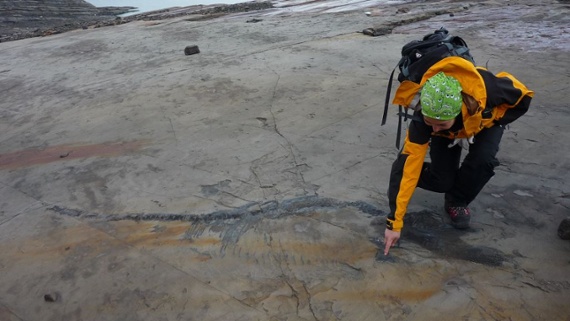
Judith Pardo Pe´rez with the ichthyosaur skeleton in Chile. (Image credit:
Alejandra Zu´n~iga)
In the shadow of a massive Patagonian glacier, paleontologists have unearthed a rare fossil find: an ancient marine reptile that died while pregnant. This dolphin-like creature, called an ichthyosaur, is the first of its kind to be discovered in Chile, where it was retrieved from a dig site near the Tyndall Glacier in the Southern Patagonian Ice Field.
"This site is really unique, because it’s capturing a time period in Earth’s history where we don’t have a very good fossil record for marine reptiles," Erin Maxwell, an ichthyosaur specialist and curator of marine reptiles at the State Museum of Natural History in Stuttgart, Germany who helped excavate the fossil, told Live Science.
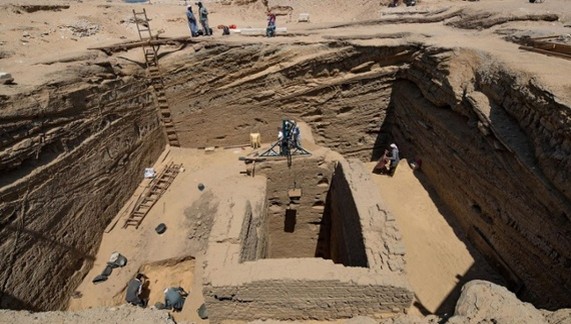
Ichthyosaurs (which translates to "fish lizards") dominated the seas beginning in the early Triassic period, about 251 million years ago, and they lived concurrently with dinosaurs until about 95 million years ago, according to the University of California Berkeley(opens in new tab). These formidable marine reptiles mostly ate ancient, hard-shelled squid relatives, as well as some types of fish and smaller ichthyosaurs. The smallest ichthyosaur species grew to measure around 1.3 feet (0.4 meters) long, while the largest reached nearly 69 feet (21 meters) from snout to tail, according to (opens in new tab)National Geographic.
At 13 feet (4 meters) long, the Tyndall ichthyosaur is a medium-sized specimen that dates to around 129 to 139 million years ago, in the early part of the Cretaceous period (about 145 million to 66 million years ago).
https://www.livescience.com/pregnant-ichthyosaur-fossil-chile?utm_source=SmartBrief&utm_medium=email&utm_campaign=368B3745-DDE0-4A69-A2E8-62503D85375D&utm_content=5DD54D0C-BC86-4576-82B7-FED40BE77B28&utm_term=33fcb0f1-f2b6-4f1c-8537-5e81e2ec5f62
-------------------------------------------------------------------------------------------------------
Octopuses torture and eat themselves after mating. Science finally knows why.
By Stephanie Pappas published 22 days ago
She even eats pieces of her own arms.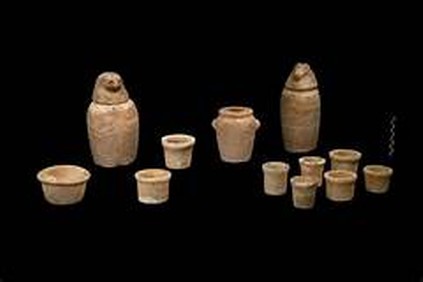
The California two-spot octopus (Octopus bimaculoides) has a circular blue eyespot on
both sides of its head. (Image credit: Tom Kleindinst/Marine Biological Laboratory)
Many animal species die after they reproduce. But in octopus mothers, this decline is particularly alarming: In most species, as an octopus mother's eggs get close to hatching, she stops eating. She then leaves her protective huddle over her brood and becomes bent on self-destruction. She might beat herself against a rock, tear at her own skin, even eat pieces of her own arms.
Now, researchers have discovered the chemicals that seem to control this fatal frenzy. After an octopus lays eggs, she undergoes changes in the production and use of cholesterol in her body, which in turn increases her production of steroid hormones — a biochemical shift that will doom her. Some of the changes may hint at processes that explain longevity in invertebrates more generally, said Z. Yan Wang, an assistant professor of psychology and biology at the University of Washington.
"Now that we have these pathways, we're really interested to link them to individual behaviors, or even individual differences in how animals express these behaviors," Wang told Live Science.
Programmed to die
Even as an English-major undergraduate student, Wang was intrigued by female reproduction, she said. When she transitioned into graduate school in science, she kept that interest, and was struck by the dramatic deaths of octopus mothers after they laid their eggs. No one knows the purpose of the behavior. Theories include the idea that the dramatic death displays draw predators away from eggs, or that the mother's body releases nutrients into the water that nurture the eggs. Most likely, Wang said, the die-off protects the babies from the older generation. Octopuses are cannibals, she said, and if older octopuses stuck around, they might end up eating all of each other's young.
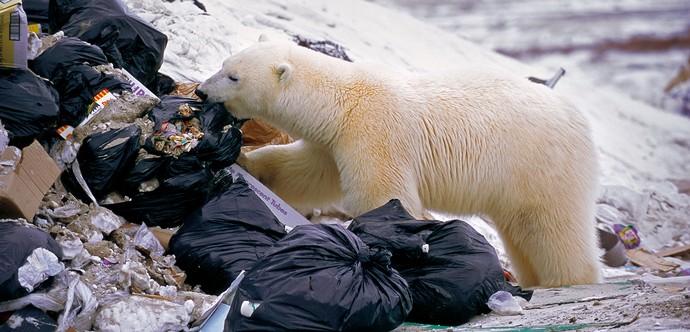
This California two-spot octopus (Octopus bimaculoides) is brooding its
eggs — the sacs that look like teensy water balloons.
(Image credit: Phil Garner / Alamy)
Octopuses are hard to study in captivity because they require a lot of space and perfect conditions for them to grow to sexual maturity and breed. Wang and other octopus researchers have now worked out a way to keep the lesser Pacific striped octopus (Octopus chierchiae) alive and breeding in the lab. Unlike most other octopus species, Pacific striped octopuses can mate multiple times and brood multiple clutches of eggs. They don't self-destruct as their eggs get ready to hatch, making them perfect specimens for studying the origin of the morbid behavior.
Advertisement
"I'm really, really excited to study the dynamics of the optic gland in that species," Wang said.
https://www.livescience.com/why-octopus-moms-self-destruct?utm_source=SmartBrief&utm_medium=email&utm_campaign=368B3745-DDE0-4A69-A2E8-62503D85375D&utm_content=2507BBB2-E8A8-4B5D-B313-5B66E795BB6E&utm_term=33fcb0f1-f2b6-4f1c-8537-5e81e2ec5f62
----------------------------------------------------------------------------------------------------
Footage of bizarre metallic UFO shown by Pentagon officials at historic hearing
By Ben Turner published 23 days ago
UFO sightings are "frequent and continuing," Pentagon officials said.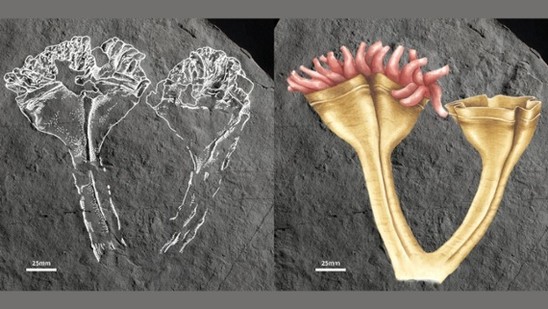
U.S. Navy videos of alleged UFO sightings were previously available but
had not been officially declassified. (Image credit: U.S. Navy)
Editor's note: The headline of this article has been updated to indicate that the UFO in question may not have been "hypersonic," as had been stated previously.
Pentagon officials speaking at the first public hearing on UFOs since the 1960s have shown previously classified footage of an unidentified aerial phenomenon (UAP), a split-second video of a metallic sphere zooming across the flight path of a military jet.
The object, captured through the cockpit window of an FA-18 fighter jet in 2021, was also seen by the Navy pilot flying the jet and picked up by the plane's sensors. But what exactly it could be remains a mystery.
Deputy Director of Naval Intelligence Scott Bray presented the video to representatives during a public hearing held by a House Intelligence subcommittee that saw lawmakers grill him and one other intelligence and defense expert on multiple reports by military pilots of mysterious unidentified aerial phenomena. The focus of the hearing was a June 2021 Pentagon report that revealed U.S. Navy pilots had reported 144 sightings of UAPs since 2004, most of which the department concluded "probably do represent physical objects."
Responding to questions from representatives on the nature of the object, Deputy Director of Naval Intelligence Scott Bray said "I do not have an explanation for what this specific object is." He remarked that, since the release of last year's report, the number of reported UAP sightings has grown to more than 400 and that the incidents — many of which occurred in military training areas and designated airspaces and remain unidentified — were "frequent and continuing."
Of the 144 UAP sightings included in the June 2021 report, 18 displayed extremely unusual flight behaviors, with the mysterious objects appearing to "remain stationary in winds aloft, move against the wind, maneuver abruptly or move at considerable speed, without discernible means of propulsion," according to the report. Released video clips also showed some of these ostensibly propulsionless craft moving at hypersonic speeds, Live Science previously reported, and one piece of footage (captured by the U.S. Navy) appears to show a spherical UFO hovering in midair while bouncing from side to side, before plunging into the ocean.
"This hearing and our oversight work has a simple idea at its core: Unidentified aerial phenomena are a potential national security threat, and they need to be treated that way," meeting Chair and Indiana Rep. André Carson said in his opening remarks.
Also giving testimony at the hearing was Undersecretary of Defense for Intelligence and Security Ronald Moultrie, an advisor to Secretary of Defense Lloyd Austin and the organizer of the new Airborne Object Identification and Management Synchronization Group (AOIMSG) that was set up to track UAPs. Moultrie said that the Pentagon could not rule out the possibility that the sightings could be connected to extraterrestrial life.
"There are elements of our government engaged in looking for extraterrestrial life," Moultrie said, referring to NASA. "Our goal is not to potentially cover up something, it's to understand what's maybe out there."
https://www.livescience.com/ufo-hearing-metallic-hypersonic-flying-object?utm_source=SmartBrief&utm_medium=email&utm_campaign=368B3745-DDE0-4A69-A2E8-62503D85375D&utm_content=2507BBB2-E8A8-4B5D-B313-5B66E795BB6E&utm_term=33fcb0f1-f2b6-4f1c-8537-5e81e2ec5f
-------------------------------------------------------------------------------------------------------------------
Stop picking carnivorous penis plants, Cambodian environmental officials plead
By Patrick Pester published 23 days ago
People picking penis pitcher plant poses problems.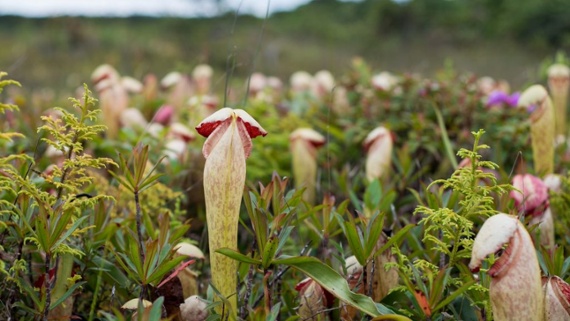
Nepenthes pitcher plants have modified leaves that look phallic. (Image credit: Shutterstock)
The Cambodian government recently asked people to stop picking a rare carnivorous plant that, when viewed from a certain angle, looks a lot like human male genitalia.
The Cambodian Ministry of Environment shared images on Facebook of three women snatching up pitcher plants and posing with them, and ministry officials requested that members of the public leave the rare plants alone, Cambodian news website the Khmer Times(opens in new tab) reported.
"What they are doing is wrong and please don’t do it again in the future!" The Ministry of Environment wrote on May 11 in the Facebook post(opens in new tab). "Thank you for loving natural resources, but don’t harvest so it goes to waste!"
Some news websites have reported that this plant is Nepenthes holdenii, but it's actually a closely related species called Nepenthes bokorensis, Jeremy Holden, a freelance wildlife photographer who first discovered N. Holdenii, and François Mey, a botanical illustrator who described both species, separately told Live Science.
N. holdenii and N. bokorensis are similar in appearance and both only occur on nearby mountain ranges, which may explain the confusion. However, N. holdenii is the rarer of the two species and only a few researchers know where to find it.
"My plant [N. holdenii] grows at a few secret locations in the Cardamom Mountains," of southwestern Cambodia, Holden said. "Bokorensis occurs on the far more accessible Phnom Bokor, which has undergone extensive development in recent years."
The Ministry of Environment's Facebook post and photos were responding to a video filmed on May 11 that showed the women picking the plants, according to Newsflare(opens in new tab), a website that buys and licenses videos. This isn't the first time the government has issued a warning against harming the phallic and photogenic plants; senior officials at the ministry asked tourists not to pick N. bokorensis and N. holdenii in a statement(opens in new tab) in July 2021, because the activity could drive the plants to extinction.
https://www.livescience.com/carnivorous-penis-pitcher-plant-picked?utm_source=SmartBrief&utm_medium=email&utm_campaign=368B3745-DDE0-4A69-A2E8-62503D85375D&utm_content=2507BBB2-E8A8-4B5D-B313-5B66E795BB6E&utm_term=33fcb0f1-f2b6-4f1c-8537-5e81e2ec5f62
-------------------------------------------------------------------------------------------------------------
Giant squid that washed up on a South African beach was 'incredible to see'
By Joanna Thompson
The massive sea creature measured nearly a dozen feet long.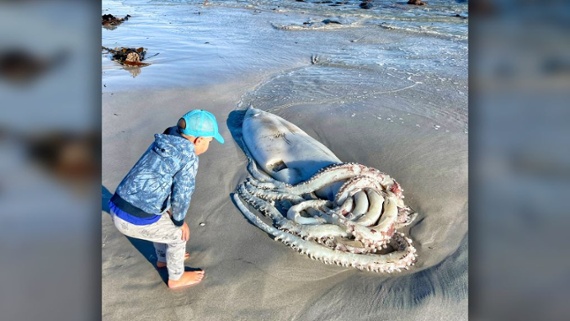
Giant squids live in the deep ocean, and rarely wash up on beaches.
Giant squids live in the deep ocean, and rarely wash up on beaches. (Image credit: Alison Paulus)
On April 30, beachgoers in Kommetjie, South Africa encountered a rare sight: a giant squid carcass glistening on the sand at Long Beach.
"It was incredible to see," Alison Paulus, a Cape Town resident and founder of the wildlife conservation organization Volunteer and Explore, told Live Science in an email. "The body was around 2.2 meters [7.2 feet] alone, then with the tentacles and arms I'm sure it would have stretched to 3.5 meters [11.5 feet]."
Giant squids are among the most elusive animals on the planet. They live at ocean depths between 1,000 to 3,000 feet (300 to 1,000 m) and only rarely rise to the sea surface. For centuries, the only information scientists had about these creatures came from studying beached carcasses or remains found in the bellies of sperm whales — the first photos of a live giant squid weren’t captured until 2004, according to National Geographic(opens in new tab).
Spotting a giant squid on a South African beach is rare, though not unheard of. A beautifully preserved baby giant squid washed up near Cape Town in 2020, the Washington Post reported. Another adult specimen that washed ashore in the same area in 1992 was just over 30 feet (9 m) long, Devon Bowen, a digital manager at Two Oceans Aquarium in Cape Town, told the South African news site Independent Online (IOL).
https://www.livescience.com/giant-squid-washes-ashore-south-africa?utm_source=SmartBrief&utm_medium=email&utm_campaign=368B3745-DDE0-4A69-A2E8-62503D85375D&utm_content=AE5B5C29-8181-4930-B7BA-BDD0CCABDC57&utm_term=33fcb0f1-f2b6-4f1c-8537-5e81e2ec5f62
-------------------------------------------------------------------------------------------------------------
Remains of Aztec dwelling and floating gardens unearthed in Mexico City
By Emily Staniforth published 21 days ago
Other finds reveal how the area transformed over the centuries.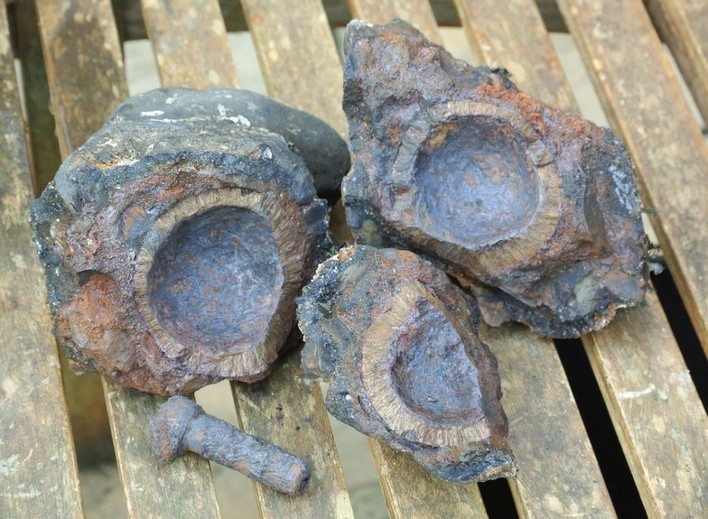
Archaeologists have uncovered the ruins of a dwelling that was built up to 800 years ago during the Aztec Empire in the Centro neighborhood of Mexico City, Mexico, during works to modernize the area.
The centuries-old abode was discovered by archaeologists and construction workers ahead of an initiative to update electrical power substations.
The dwelling is believed to date from the late Postclassic period (A.D. 1200 to 1521) and would have been located on the border of two neighborhoods in the city of Tenochtitlan, the capital of the Aztec Empire, according to a statement from Mexico's National Institute of Anthropology and History(opens in new tab) (INAH). It spans over 4,300 square feet (400 square meters), or about half the size of a baseball diamond.
During the late Postclassic, the area that is now being excavated was a residential and agricultural center, and archaeologists at the site also found the remains of channels and a jetty (a platform where boats stop to load or unload) used in the Aztec chinampa method of farming. The chinampa technique involved growing crops on small areas of artificial land (sometimes referred to as floating gardens) on shallow lake beds.
Archaeologists found more Aztec artifacts in the residential area of the excavations. Under the Aztec building's thick adobe floors, the excavation team found a pair of funerary vessels that contain the bone remains of infants, as well as several burials associated with an offering of censers (vessels in which incense is burned), whorls (a spinning machine or spindle) and spinning tools.
The researchers also unearthed a stone statue that stands just over 23.5 inches (60 centimeters) tall. The statue, also from the late Postclassic period, depicts a man wearing a loincloth who looks as if he is throwing something. Archaeologists believe that the statue may have been unfinished, as it lacks polish on the body, and they speculated that it may have been hidden at the time of Spanish intervention in the Aztec Empire, which began around A.D. 1521 according to the statement.
https://www.livescience.com/aztec-house-discovered-mexico?utm_source=SmartBrief&utm_medium=email&utm_campaign=368B3745-DDE0-4A69-A2E8-62503D85375D&utm_content=7C1B0C11-5631-4C79-A604-161F30B3E956&utm_term=33fcb0f1-f2b6-4f1c-8537-5e81e2ec5f62
-----------------------------------------------------------------------------------------------------------------
Why are there so many giants in the deep sea?
By Donavyn Coffey
It may be that survival demands it.
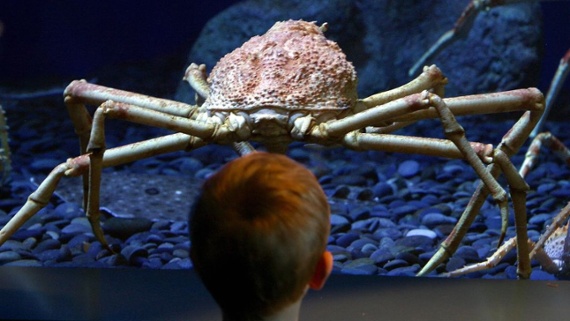
Three-year old boy looking at a spider crab at the aquarium. Robyn Beck/AFP via Getty Images
Three-year old Brendan Gulbransen of Los Angeles gets his head around a spider crab during a visit to the Aquarium of the Pacific in Long Beach, California on May 20, 2004. (Image credit: Robyn Beck/AFP via Getty Images)
In the deepest and coldest parts of the ocean, sea creatures — mainly invertebrates, or animals without backbones — can reach gargantuan proportions. Squids, sea spiders, worms and a variety of other types of animals grow to sizes that dwarf related species around the world. The phenomenon is called gigantism.
The colossal squid (Mesonychoteuthis hamiltoni) in subantarctic waters is about 14 times longer than the arrow Squid (Nototodarus sloanii) common to New Zealand, according to Te Ara the Encyclopedia of New Zealand(opens in new tab). Deep in the remote Pacific waters there's a sea sponge the size of a minivan. But what is it about deep and frigid ocean waters that causes creatures to grow so big? It may be that survival demands it, and factors in the extremely cold waters enable it to happen.
In the deepest parts of the ocean, resources are severely limited, much as they are in island ecosystems, according to a study published in 2006 in the Journal of Biogeography(opens in new tab). Much of the food originates in shallower waters and only a fraction of that trickles down to the sea depths. When food is scarce, being bigger provides a huge advantage, according to Alicia Bitondo, a senior aquarist at the Monterey Bay Aquarium in California, who works with deep sea species.
Larger animals can move faster and farther to find food or to locate a mate. They have more efficient metabolisms and are better at storing food. So when something like a big carcass drifts down to deeper waters, big predators can consume more and store that energy for a longer time, Bitondo said.
Cold temperatures in the deep sea can also fuel gigantism by significantly slowing down animals' metabolisms. Creatures in this ecosystem often grow and mature very slowly, such as the Greenland shark (Somniosus microcephalus), Bitondo said. This slow-moving shark can grow to be 24 feet (7.3 meters) long and can weigh up to 1.5 tons (1.4 metric tons), but that growth is spread out over a lifespan that extends for centuries. Greenland sharks grow approximately 0.4 inches (1 centimeter) per year and don't reach sexual maturity until they're around 150 years old, Bitondo said. It's due, in part, to a lack of predators in the deep sea that these sharks can live so long and grow so large, she added.
https://www.livescience.com/why-deep-sea-animals-are-giants?utm_source=SmartBrief&utm_medium=email&utm_campaign=368B3745-DDE0-4A69-A2E8-62503D85375D&utm_content=7C1B0C11-5631-4C79-A604-161F30B3E956&utm_term=33fcb0f1-f2b6-4f1c-8537-5e81e2ec5f62
----------------------------------------------------------------------------------------------------------
Do trees exist (scientifically speaking)?
By Ashley Hamer
How did they even evolve?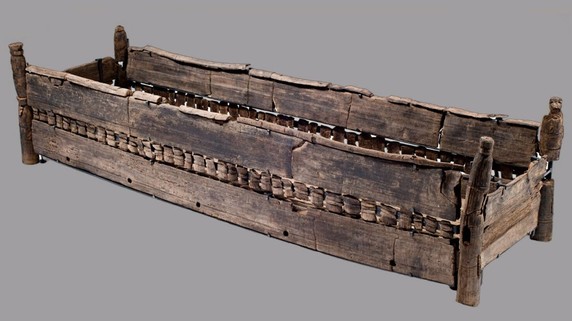
If you look at an evolutionary diagram, you can see where Homo sapiens branched off from other primates. You can see where apples branched off from the rest of the rose family. But you won't see where trees branched off from other plants. That's because they never did.
Trees are not a species, or even a family or an order. So do trees even exist, scientifically?
Tom Kimmerer, a consulting forest scientist based in Kentucky, said yes — just not in the way you might think.
"Many years ago I asked my daughter Larkin, 'What's a tree?'" Kimmerer told Live Science. "And she could recognize them without fail. If a kid could recognize it, then a tree is some real entity we can recognize, even if the definition is difficult."
Related: Why does freshly cut grass smell so nice?
Kimmerer said a tree is simply a solution to a problem, and that problem is access to light.
The earliest plants on land were herbaceous — soft, non-woody plants like herbs and grasses that generally grow low to the ground. But the moment one plant grew taller than the others, there was competition for sunlight.
"The attribute of being a long-lived — that is, perennial — plant that keeps its leaves above the leaves of the rest of the plants is what leads to a tree," Kimmerer said. "All the other things that happen to trees have to happen in order for that to work efficiently."
For example, trees have thick trunks to support the weight above them and help them reach greater heights, and therefore more sunlight. Trees also have an efficient plumbing system to draw water up that high and bring nutrients back down — that's thanks to xylem and phloem, the tissues that form a tree's rings.
Trees also have large, efficient root systems to supply all that water.
Herbaceous plants have many of these features too: they have stems to support their weight, they have xylem and phloem to carry water and nutrients, and they have root systems. These features just don't have to do as much as they would in a plant that's several hundred feet tall.
Herbaceous plants also aren't made of wood — and wood makes all the difference.
"Wood is one of the most amazing structures in the world because it's an adaptation that simultaneously solves multiple problems," Kimmerer said.
Wood does three things that are absolutely necessary for a tree: it's firm and flexible enough to support a tree's height, it's great at transporting water a long distance, and it's great at storing sugar. Without wood, trees would buckle under their own weight and struggle to get enough water and nutrients.
But as similar as their characteristics are, trees aren't all related to each other. They're just a habit, or a form that a plant can take. You can find trees all over the evolutionary map.
"There are lots of [plant] families that are only herbaceous," Kimmerer said. "There are even more families that have both herbaceous and tree members. And then there are a few families that are only trees."
"If I were to show you a picture of a thousand different species of trees, you'd go, 'Wow, they're all different,'" Kimmerer added. "Just like we're all different. But their fundamental attributes are the ones that make a tree."
https://www.livescience.com/are-trees-real?utm_source=SmartBrief&utm_medium=email&utm_campaign=368B3745-DDE0-4A69-A2E8-62503D85375D&utm_content=7C1B0C11-5631-4C79-A604-161F30B3E956&utm_term=33fcb0f1-f2b6-4f1c-8537-5e81e2ec5f62
--------------------------------------------------------------------------------------------------------------
Submerged human corpses rise from drought-stricken Lake Mead
By Mindy Weisberger
The first body was found on May 1.

A rusted metal barrel, near the location of where a different barrel was found containing a human body, sits exposed on shore during low water levels due to the western drought at the Lake Mead Marina on the Colorado River in Boulder City, Nevada. (Image credit: Patrick T. Fallon/AFP via Getty Images)
First the drought came. Then, the bodies started washing up.
For over a decade, water levels have been plummeting in Nevada's Lake Mead, the biggest reservoir in Clark County, Las Vegas, and one of the largest reservoirs in the United States. On May 1, receding waters due to regional drought led officials to a gruesome discovery on the reservoir's shore: a metal barrel holding a corpse that had been dumped into the water more than 30 years ago, CNN reported(opens in new tab).
Just a few days later, more human remains emerged in Lake Mead's Callville Bay, National Park Service (NPS) representatives said in a statement(opens in new tab). A witness reported finding "human skeletal remains" on May 7 at approximately 2 p.m. local time, and NPS rangers responded to the call and recovered the remains.
They contacted the Clark County Medical Examiner to analyze the bones, but the cause of death has yet to be determined and at the time there is "no evidence to suggest foul play," police officers told KTNV Las Vegas(opens in new tab).
Related: Drought helped push the Vikings out of Greenland, new study finds
The clothes and footwear found on the decomposed body in the barrel \suggested that the person died "sometime in the mid '70s to early '80s," Las Vegas Metropolitan Police Department (LVMPD) representatives said in a statement(opens in new tab).
"We believe this is a homicide as a result of a gunshot wound," said LVMPD Homicide Section Lt. Ray Spencer. The victim's identity is unknown, but such information "will be released by the Clark County Coroner's Office when it becomes available," LVMPD representatives said.
Two sisters found the second set of remains — a human jawbone with attached teeth — on an exposed sandbar while they were paddle-boarding on the lake, ABC News reported(opens in new tab).
Lake Mead provides water for more than 40 million people across seven states and into northern Mexico; it is formed by the Hoover Dam and fed by the Colorado River, and it lies about 30 miles (48 kilometers) east of Las Vegas, according to the NPS(opens in new tab). At maximum capacity, Lake Mead holds 9.3 trillion gallons (36 trillion liters) of water, according to NASA Earth Observatory(opens in new tab) (NEO). But the last time the reservoir was anywhere near full capacity was in 1999, and water levels have been dropping steadily ever since. Warming temperatures fueled by climate change are worsening persistent drought conditions that may be the region's worst dry spell in more than 1,000 years, NEO reported.
In August 2020, Lake Mead's waters reached only about 35% percent of its capacity. On May 9 of this year, Lake Mead's water level measured about 1,052 feet (321 meters) above sea level — roughly 162 feet (49 m) lower than in 2000, and the lowest level on record since the 1930s, CNN reported.
https://www.livescience.com/drought-lake-bodies?utm_source=SmartBrief&utm_medium=email&utm_campaign=368B3745-DDE0-4A69-A2E8-62503D85375D&utm_content=32AADDE9-8C04-4437-8806-D22B3941B400&utm_term=33fcb0f1-f2b6-4f1c-8537-5e81e2ec5f62
--------------------------------------------------------------------------------------------
Extinction threatens one in five reptile species, researchers say
By David Crookes
Researchers have carried out the most comprehensive study
of reptile species to identify extinction risks.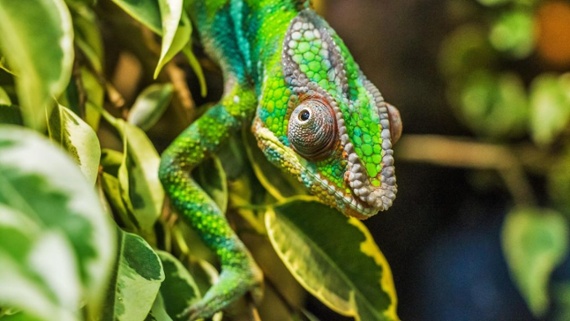
A chameleon among foliage. Human settlements, the pet trade, traditional medicine,
logging and agriculture are pushing some reptile species towards extinction
(Image credit: Bergadder / Pixabay)
More than one-fifth of reptile species across the globe are threatened with extinction, with those living in forests found to be in far greater danger than those inhabiting arid areas, a new study reports.
In the most comprehensive extinction-risk assessment ever carried out on reptiles, researchers discovered that as many as 21.1% of all known species were at risk.
"It's just overwhelming the number of species that we see as being threatened," said study co-author Neil Cox. The researchers published their findings on April 27 in the journal Nature(opens in new tab).
Prior to this new research, there had been no formal attempt to determine how many reptiles were at risk of extinction. Instead, conservationists relied on the International Union for Conservation of Nature's (IUCN) Red List of Threatened Species(opens in new tab), which provides the risk status of birds, mammals and amphibians.
By using the Red List's criteria, the study researchers discovered 1,829 out of 10,196 reptile species were vulnerable, endangered or critically endangered — a total of 21.1% of the known species.
They also found that 57.9% of turtles and 50% of crocodiles are threatened; overall, 40.7% of amphibians, 25.4% of mammals and 13.6% of birds are considered threatened by the IUCN, according to the Red List.
The global study was carried out over 15 years with the help of 961 researchers representing 24 countries across six continents.
For the study, researchers assessed preexisting surveys and datasets of turtles, crocodiles, lizards, snakes and tuatara in Africa, the Americas, Asia, Australia, the Caribbean, Europe and Oceania. Tuatara are endemic to New Zealand and are considered to be the last survivors of an order of reptiles that can be "traced back to the Triassic period, according to the New Zealand Department of Conservation(opens in new tab).
The authors said reptiles were being threatened globally by agriculture, logging, urban development and invasive species. This would explain why the researchers found that 30% of reptiles living in forests were at risk of extinction compared to 14% of reptiles living in arid habitats, the authors said.
https://www.livescience.com/extinction-threatens-one-fifth-reptile-species?utm_source=SmartBrief&utm_medium=email&utm_campaign=368B3745-DDE0-4A69-A2E8-62503D85375D&utm_content=926899C6-5F8A-49B7-81DA-E9A761A13780&utm_term=33fcb0f1-f2b6-4f1c-8537-5e81e2ec5f62
------------------------------------------------------------------------------------------
Veverka Updates 10 June 2022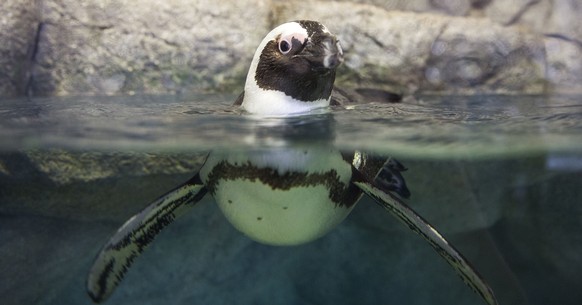
John is pleased to have been selected to become a Technical Service Member
of the PUP Global Heritage Consortium. John will provide technical services for projects involving heritage interpretation planning and training.
The PUP Global Heritage Consortium unites people and organizations dedicated to introducing emerging paradigms in heritage management and planning. It focuses on stemming the tide of non-implemented natural and cultural heritage management plans and transitioning to a more holistic, integral management approach. Ultimately this improves conservation of biological and cultural diversity. PUP Global Heritage Consortium - Home (pupconsortium.net)
-------------------------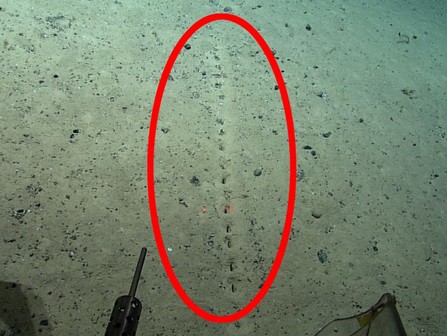
I recently had the pleasure of joining the Polaris Museum Mentor Network. The network helps link up folks looking to enter the museum field or thinking about museum career changes, with experienced professions (mentors) in the museum or heritage field. Having taught University Courses (and mentored students in heritage interpretation) I was/am happy to become a mentor for folks looking to work in museums or within Heritage Interpretation fields. To learn more about Polaris and either "look for a mentor" or donate hour time to be a mentor, you can visit their web site for more information.
The mentoring services are provided FREE. https://museummentors.org
**************************************
John Veverka - 10 June 2022. Based on the recent hurricane (extreme weather) and the extreme flooding occurring (1-3 September), you may be interested in two of our InterpNEWS special climate publications on the Climate Crisis. One resource issue on Extreme Weather and one issue on Climate and Flooding. These two publications are available as PDF' for FREE. Visit our Climate Change Resource Center for more climate issues. If you want these two issues just send me an e-mail with your e-mail and I will send them to you (jvainterp@aol.com).
http://www.heritageinterp.com/hitc_climate_crisis_resource_center.html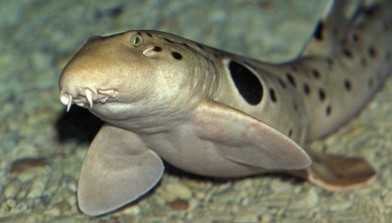
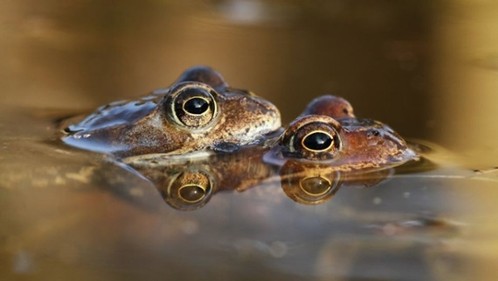
---------------
Veverka - 10 June 2022 - Interpretive Planning Textbooks at the Heritage Interpretation Bookstore.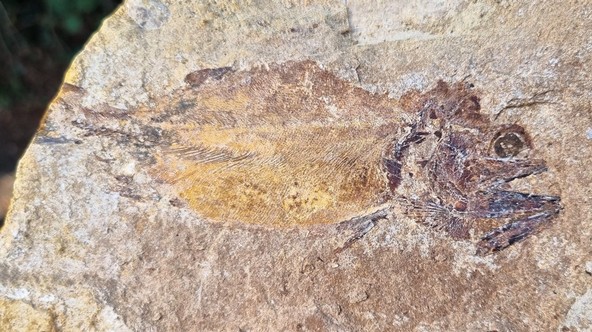
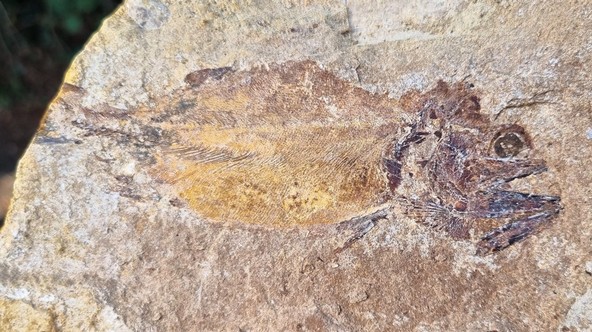
I have a library of Interpretive Planning e-Textbook that I use as texts for my interpretive training courses. Subjects include: Interpretive Master Planning, Advanced Interpretive Planning, The Interpretive Trails Book, Interpretive Writing Text Book and others. You can visit the Book Store Web Site to check them out.
http://www.heritageinterp.com/interpretation_book_store.html
________________
An ending smile.
---------------------------------------------------------------------------------------------------------------------
--------------------------------------------------------------------------------------------------------------------------------